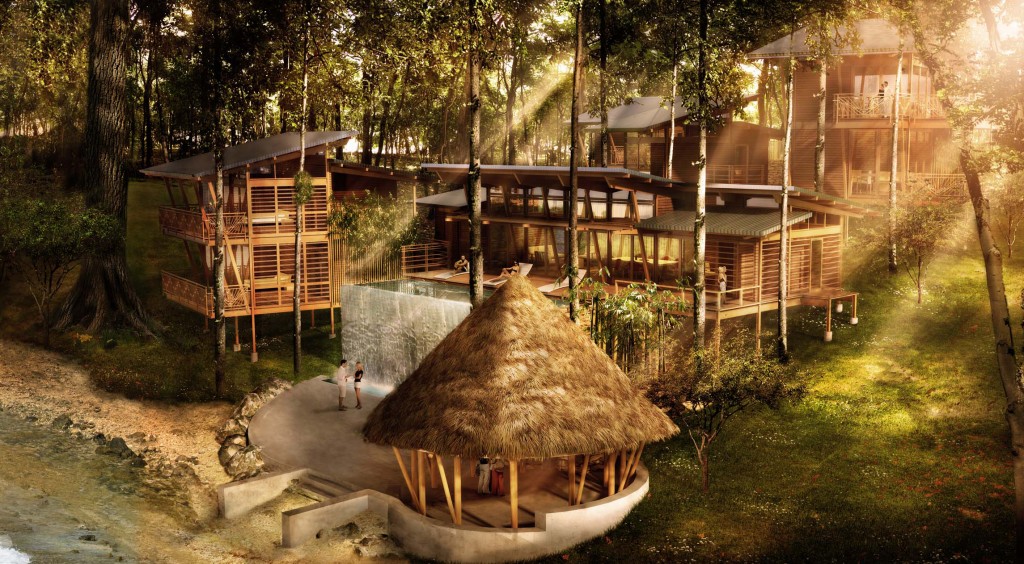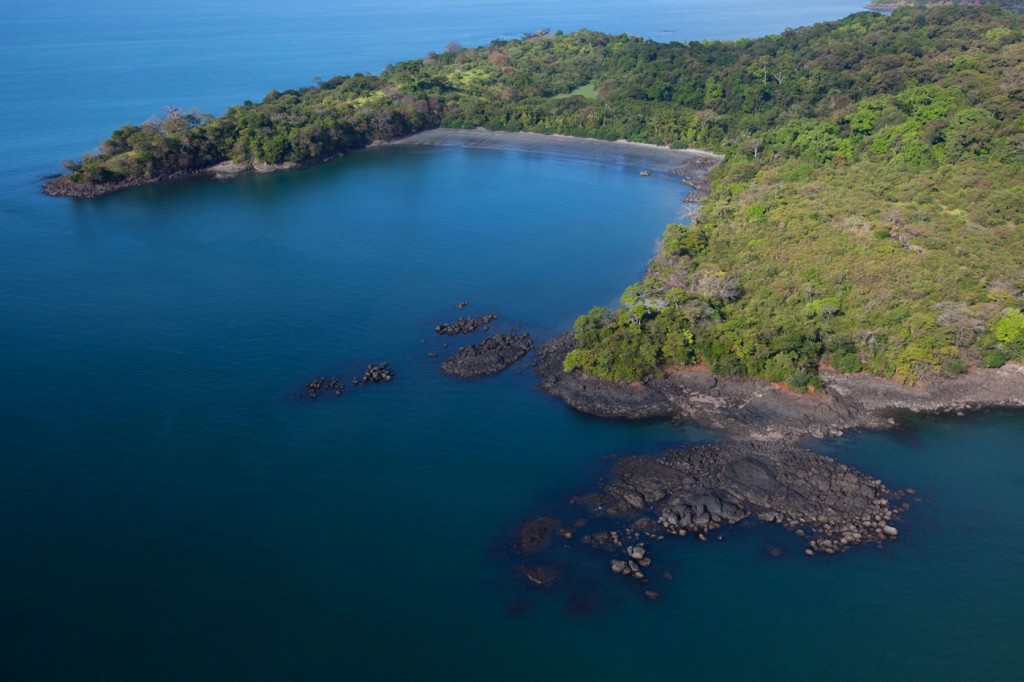As our boat accelerates over the shimmering silver of the Pacific under overcast skies, a tuft of green slips into view. “Palenque,” proclaims Irving, our boat driver. The Spanish word rolls off his tongue with reverence and he smiles beneath his sun-bleached beard, proud to be the one announcing the island.
I scan the coastline for the resort as we continue to zoom towards Isla Palenque. I’d seen recent photos and knew it to be nearing completion, walls and roofs materializing with astonishing speed. My search yields nothing but an eyeful of lush jungle; as the boat draws nearer; I note gardens of volcanic rock, expanses of untrodden sand flanked by flowering trees and overhung by palms, and coastal bluffs comprised of massive boulders and rutted by dark crevices leading who knows where. Ben, my boss, points to one of these shadowy places, informing me that it is a newly-discovered bat cave. This island holds countless secrets, but the greatest mystery confronting me just then was where they’d hidden the resort.
The day after my arrival, I stand on Playa Primera with my back to the incoming waves, looking up at the estate rooms and suites from a distance of 20 meters. Already they’ve begun their disappearing trick, affording only a glimpse of an architectural line here and there between the trees. Looking out from the deck of a suite or beachfront home, the oceanview stretches to infinity, but turn around and the resort is completely camouflaged in wall-to-wall jungle. While the illusion seems magical, it is of course, by design.
“We wanted to keep the island’s natural features in the foreground, so we worked to integrate the structures into their existing environment,” explains Benjamin Loomis while leading my tour of the guestrooms to check out the view from each. Ben is the founder of Amble Resorts’ and the leading architect behind its premier Panama resort. Also, as Isla Palenque’s most seasoned explorer, Ben’s guidance during my maiden visit to the island is especially valuable. It’s not easy to wrap buildings around trees in the middle of the dense jungle encompassing most of this 400-acre island in Panama’s Gulf of Chiriqui – nor is it common practice among developers in this up-and-coming travel and real estate haven.
Significant pains have been taken to avoid cutting down any tree greater than 6 inches in diameter, and the result is a collection of guestrooms and stunning residences sheltered by old-growth forest and joined by outdoor walkways that immerse visitors in the wild world of Isla Palenque’s jungle. The award-winning master plan for The Resort at Isla Palenque embraces sustainability at its very core and has been carried out admirably in the completion of its Phase One hotel. The six estate rooms and ten canvas-walled tented suites that comprise this first phase of the eco-development each incorporate passive design techniques, maximizing shade and airflow to minimize reliance on A/C.
Constructed of sustainably-sourced indigenous hardwoods and bamboo, the guestrooms nestle into the cliff-side overlooking pristine beaches and seamlessly blending into their lush surroundings. The rewards of a stay in any of these ingeniously-designed rooms: exotic bird sightings at breakfast, monkey-spotting from your deck, and manifold opportunities to connect with nature in stylish, sustainable luxury.


Estate Rooms at Isla Palenque
As a member of Amble Resorts’ marketing team, I’ve been invited to the island to see it before our first guests arrive later this year. However, I’m not here to try out the luxurious guest accommodations on Playa Primera; rather, my stay more closely emulates that of our architects in their visits to the island during design and planning phases: I’m sleeping in an actual tent.
Nevertheless, the Isla Palenque team ensures that I’m well cared-for throughout my trip. Fresh towels for my outdoor showers in the shade of the canopy made it great fun to get dirty with long daily hikes to different parts of the island. And I loved the smiling invitation to “pruebalo!” (“try it!”) tendered over a plate of pixbae one midmorning back-of-house. If you’re tentative to sample strange foods, I found that the best way to get over this is to have a friendly Panamanian suggest them to you. I couldn’t say no, and I’m glad I didn’t – the pixbae were scrumptious.
Encounters with the locally-sourced hotel operations staff treated me to a taste of the personalized service they’ll be offering guests of The Resort at Isla Palenque. By week’s end, I’ve a host of reasons for cherishing this chance to experience Isla Palenque raw, living so close to the ocean that the waves lulled me to sleep each night, and under a brilliant green canopy that softened the bright sun as I woke each morning.
Since less than 5% of the island’s total area will be developed at full build-out, the undisturbed wilderness I explored during my visit is the same one our guests and homeowners will have privileged access to, along with subtle but sensuous touches of added comfort. The low-impact development philosophy espoused by Ben and the team at Amble Resorts hearkens to their many thrilling adventures in this unique Panamanian wilderness. After several years of hiking Isla Palenque, Ben still makes novel discoveries in its diverse jungle, coastal, and lagoon ecosystems. “We wouldn’t be building here if we weren’t certain it could be accomplished in a way that allows our guests to share the kind of wild experiences our own team members have had on this island,” he says.
Founder of Amble Resorts’ and leading architect, Benjamin Loomis, Himself an architect with 20 years of experience, Ben relies on help from the best in the industry to realize his vision for expressing the island’s genius loci through The Resort at Isla Palenque.
“Ben understands the importance of bringing the design team onsite so they can respond to it,” says Kimshasa Baldwin, LEED-accredited Director of Design for Amble Resorts. An assortment of side projects of design team members decorates the palm grove behind my tent: a grand driftwood dining set, an elegant bamboo chaise, a bench sidling up to a palm tree; it seems Isla Palenque is a muse to many.
Their artistic creations invite me to take a seat in the natural shade and wait for the creatures to start coming out. The breaks in the trees over the beach pavilion where my tent is pitched bathe my stay in tropical sunshine and luminous moonlight – and in my visit to the near-finished estate rooms, I quickly gather that our guests will relish these free amenities as well, thanks to lofty cantilevered ceilings and clerestory windows that slide away for open-air living at whim.
I did wholly miss out on one aspect of our future resortgoer’s experience: a window into the region’s culture by way of artisanal interior décor. Furniture is currently being crafted by an on-site local artisan, and the island team has been gathering indigenous handicrafts while driving the country roads of mainland Chiriqui Province. These yet-to-be-seen elements have me anxious to return once the rooms are fully outfitted in preparation for our guests.
Throughout my hikes and walks along Isla Palenque’s beaches, I grew evermore excited for the adventurers who’ll be traveling to this island’s shores in just a few short months. Everything I’d seen of the structures gave me confidence that our guests’ time on the island would permit them the same level of intimacy with nature that I had enjoyed in my tent set back from tide-washed Playa Palenque.
I’m not sure I fully grasped one of Amble Resorts’ core values until I finally witnessed it in action on Isla Palenque: a design aesthetic encompassing responsiveness to the inherent qualities of the site, as well as to the history and culture of the people who have been calling this corner of the world their home for centuries.
I returned to Chicago from my week in Panama glowing, less from imprudent sun exposure, and more from a sense of pride in what we are preparing to share with future guests. For more information or to plan your trip visit Isla Palenque


